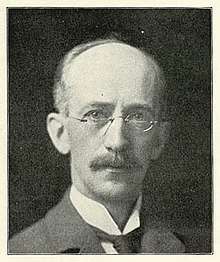Edward Brodhead Green
Edward Brodhead Green (May 10, 1855 – February 2, 1950), very often referred to as E. B. Green, was a major American architect from New York State.[1]
Edward Brodhead Green | |
|---|---|
 | |
| Born | May 10, 1855 Utica, New York, U.S. |
| Died | February 11, 1950 (aged 94) Buffalo, New York, U.S. |
| Nationality | American |
| Alma mater | Cornell University |
| Occupation | Architect |
| Spouse(s) | Harriet B. Edson
( m. 1887; died 1935) |
| Awards | Fellow of the American Institute of Architects (1890) |
| Practice | Green & Wicks, Edward B. Green & Son |
Early life
Green was born in Utica, New York on May 10, 1855.[2]
He attended Cornell University in Ithaca, New York, graduating with a bachelor of architecture degree in 1878. Following his graduation, Green was the 3rd architect to be registered by the State University of New York.[3]
Career
After graduation, Green worked as a junior architect with William Miller in Ithaca for three years while teaching at Cornell for one year. In 1880, along with William Sydney Wicks, an M.I.T. architecture graduate, he opened a practice in Auburn, New York, moving a year later to 69 Genesee Street in Buffalo, New York in 1881.[3]
Green was thereafter active in Buffalo, New York through about 1930 where his work left a lasting impression on the city of Buffalo,[4] and it includes such noteworthy structures as the Albright-Knox Art Gallery, Young Men's Christian Association Central Building, and Twentieth Century Club (1894); all three listed on the National Register of Historic Places.[5] His public buildings include the Buffalo Savings Bank, the Market Arcade, the Buffalo Crematory, and South Park High School, The First Presbyterian Church of Buffalo, Kibler High School, Tonawanda Municipal Building, and Dayton Art Institute (1930) among others.[6]
In Canada, Green made the designs for several structures owned by the Ontario Power Company at Niagara Falls, Ontario.[6]
He also designed and built many private residences, including the Charles W. Goodyear Residence, the Granger Mansion, and his own residence at 180 Summer Street, which is not visible from the road. During his 72-year career, he designed more than 370 major structures. More than 160 of his Buffalo buildings survive today.[6]
After the death of his partner Wicks in 1919, he continued the practice with his son, Edward B. Green Jr., and then with R.M. James from 1936 to 1950.[6]
 Albright Art Gallery in 1913, designed by Green and built between 1890-1905 for the Pan-American Exposition in Buffalo
Albright Art Gallery in 1913, designed by Green and built between 1890-1905 for the Pan-American Exposition in Buffalo
Personal life
In 1887, Green was married to Harriet Edson (1858–1935). Together, they were the parents of:[3]
- Edward Brodhead Green, Jr. (1888–1933), also an architect.[6][7]
- Cornelia Green (1890–1959)
- Paul Edson Green (1892–1957), also an architect.[3]
Green died in Buffalo on February 2, 1950 after a two-week illness.[2] He was buried in Forest Lawn Cemetery.[3]
See also
References
- Corcoran, Kathryn L. (1989). Edward B. Green, Architect: A Selected Bibliography. Vance Bibliographies. Retrieved 21 January 2018.
- "Edward B. Green". The New York Times. 13 February 1950. Retrieved 21 January 2018.
- LaChiusa, Chuck. "E.B. Green". buffaloah.com. Buffalo Architecture and History. Retrieved 21 January 2018.
- Goldman, Mark. City on the Edge: Buffalo, New York, 1900 - Present. Prometheus Books. p. 88. ISBN 9781615920679. Retrieved 21 January 2018.
- Western Architect and Engineer. 1908. p. 46. Retrieved 21 January 2018.
- "Green, Edward Brodhead". dictionaryofarchitectsincanada.org. Biographical Dictionary of Architects in Canada. Retrieved 21 January 2018.
- Banham, Reyner; Kowsky, Francis R.; Corporation, Buffalo Architectural Guidebook (1981). Buffalo Architecture: A Guide. MIT Press. p. 120. ISBN 9780262520638. Retrieved 21 January 2018.
External links
- E.B. Green at www.buffaloah.com